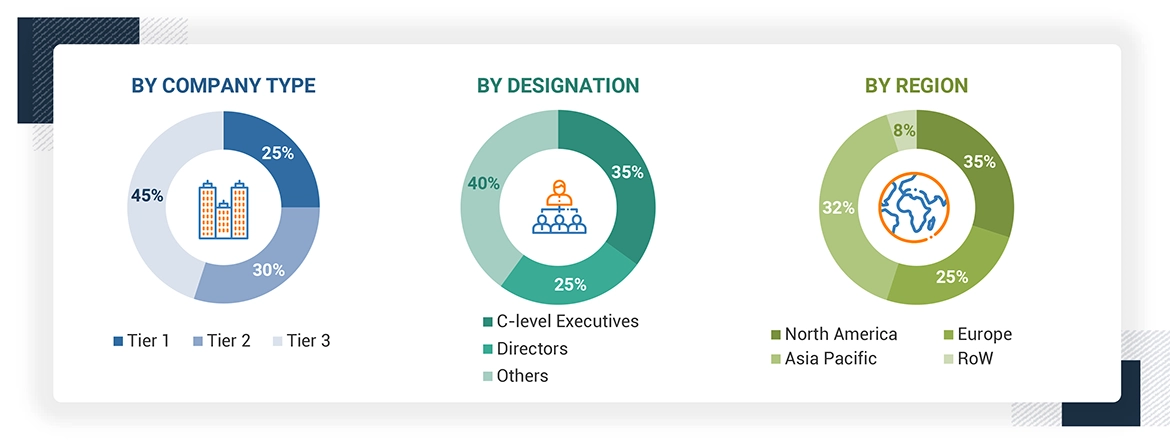The study involved major activities in estimating the current market size for the flow battery market. Exhaustive secondary research was done to collect information on the flow battery industry. The next step was to validate these findings, assumptions, and sizing with industry experts across the value chain using primary research. Different approaches, such as top-down and bottom-up, were employed to estimate the total market size. After that, the market breakup and data triangulation procedures were used to estimate the market size of the segments and subsegments of the flow battery market.
Secondary Research
The market for the companies offering flow batteries is arrived at by secondary data available through paid and unpaid sources, analyzing the product portfolios of the major companies in the ecosystem, and rating the companies by their performance and quality. Various sources were referred to in the secondary research process to identify and collect information for this study. The secondary sources include annual reports, press releases, investor presentations of companies, white papers, journals, certified publications, and articles from recognized authors, directories, and databases. In the secondary research process, various secondary sources were referred to for identifying and collecting information related to the study. Secondary sources included annual reports, press releases, and investor presentations of blockchain vendors, forums, certified publications, and whitepapers. The secondary research was used to obtain critical information on the industry's value chain, the total pool of key players, market classification, and segmentation from the market and technology-oriented perspectives.
Primary Research
Extensive primary research has been conducted after understanding and analyzing the current scenario of the flow battery market through secondary research. Several primary interviews have been conducted with the key opinion leaders from the demand and supply sides across four main regions—North America, Europe, Asia Pacific, and the Rest of Europe. Approximately 25% of the primary interviews were conducted with the demand-side respondents, while approximately 75% were conducted with the supply-side respondents. The primary data has been collected through questionnaires, emails, and telephone interviews.
After interacting with industry experts, brief sessions were conducted with highly experienced independent consultants to reinforce the findings from our primary. This, along with the in-house subject matter experts’ opinions, has led us to the findings as described in the remainder of this report. The breakdown of primary respondents is as follows:

To know about the assumptions considered for the study, download the pdf brochure
Market Size Estimation
Both top-down and bottom-up approaches were used to estimate and validate the total size of the flow battery market. These methods were also used extensively to estimate the size of various subsegments in the market. The research methodology used to estimate the market size includes the following:
Flow Battery Market : Top-Down and Bottom-Up Approach
Data Triangulation
After arriving at the overall market size using the market size estimation processes as explained above, the market was split into several segments and subsegments. The data triangulation and market breakdown procedures were employed, wherever applicable, to complete the overall market engineering process and arrive at the exact statistics of each market segment and subsegment. The data was triangulated by studying various factors and trends from the demand and supply sides.
Market Definition
A flow battery is a rechargeable battery in which the electrolyte flows through various electrochemical cells from one or more tanks. The electrochemical cells used in flow batteries can be electrically connected in series or parallel, determining the overall power of a flow battery system. Flow batteries are considered safer than most commonly used lithium-ion batteries as they are resistant to high temperatures and exhibit a longer operational life, making them suitable for storing and releasing renewable energy from solar and wind sources. The scalability of flow batteries, wherein the battery’s energy storage capacity can be increased by increasing the quantity of electrolytes stored in the tanks, is another advantage driving the demand for flow batteries in large-scale energy storage applications.
Key Stakeholders
-
Flow Battery Manufacturers
-
Government Bodies and Policymakers
-
Standards Organizations, Forums, Alliances, and Associations
-
Market Research and Consulting Firms
-
Raw Material Suppliers and Distributors
-
Research Institutes and Organizations
-
Material and Technology Providers
-
Testing, Inspection, and Certification Providers
-
End Users
-
Distributors and System Integrators
Report Objectives
-
To describe and forecast the flow battery market, in terms of value, based on battery type, storage, material, application, and vertical
-
To forecast the size of the market in terms of volume
-
To forecast the market size, in terms of value, for four main regions—North America, Europe, Asia Pacific, and the RoW (Rest of the World)
-
To provide detailed information regarding drivers, restraints, opportunities, and challenges influencing the market growth
-
To provide a detailed overview of the value chain of the flow battery ecosystem
-
To strategically analyze micromarkets1 with respect to individual growth trends, prospects, and contributions to the total market
-
To analyze the opportunities for stakeholders and details of the competitive landscape of the market
-
To strategically profile the key players and comprehensively analyze their market positions in terms of ranking and core competencies
-
To analyze the major growth strategies implemented by key market players, such as agreements, acquisitions, product launches, expansions, and partnerships
-
To study the impact of AI on the market under study, along with macroeconomic outlook for each region
Available Customizations
With the given market data, MarketsandMarkets offers customizations according to the specific requirements of companies. The following customization options are available for the report:
-
Detailed analysis and profiling of additional market players based on various blocks of the supply chain

Growth opportunities and latent adjacency in Flow Battery Market